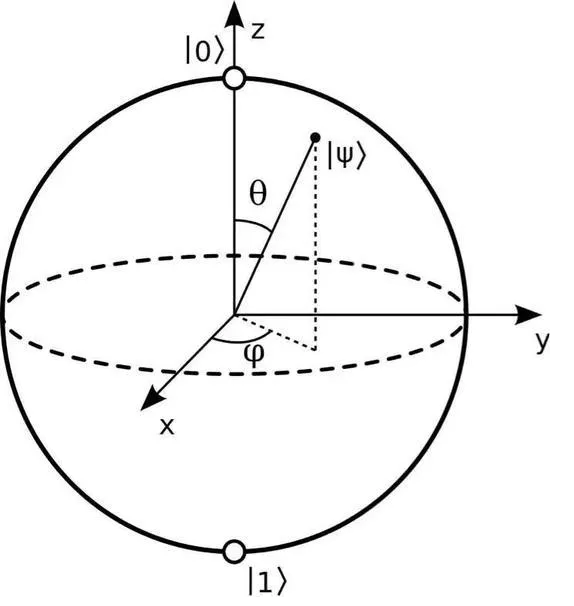Bloch Sphere
Single-qubit State
Unlike classical bits, qubits can be in both the computational basis vector
Here
For a two-dimensional Hilbert space, we can make the following mapping of the computational basis vector
Thus, any single-qubit state can be expressed as
In the general case, we do not care about the global phase, so we can assume
Here we might as well represent that arbitrary quantum state in the unit ball, as follows, taking

Next we will show how to demonstrate a single-qubit state in MindSpore Quantum and the evolution of the single-qubit state in the form of an animation.
Building Quantum Circuit
From the above bloch sphere, we can control the elevation angle
[11]:
circ = Circuit() # Build circuit for preparing an arbitrary single-qubit quantum state
circ += RX('theta').on(0) # Control elevation via RX gate
circ += RZ('phi').on(0) # Control azimuth via RZ gate
circ.svg()
[11]:
Here we might as well take
[12]:
import numpy as np
state1 = circ.get_qs(pr={'theta': np.pi/4, 'phi': np.pi/4})
print(state1)
[0.85355339-0.35355339j 0.14644661-0.35355339j]
Displaying the Quantum State
In MindSpore Quantum, BlochScene is the module used to display the Bloch sphere. We can add as many single-qubit states as we want to the BlochScene and also animate the evolution of the single-qubit quantum states.
[13]:
scene = BlochScene() # Create Bloch drawing scene
fig, ax = scene.create_scene() # Initialize the scene
state_obj1 = scene.add_state(ax, state1) # Add a quantum state to the scene
In addition, we can also show the Bloch sphere in dark mode, as follows.
[14]:
scene = BlochScene('dark') # Create Bloch drawing scene
fig, ax = scene.create_scene() # Initialize the scene
state_obj1 = scene.add_state(ax, state1) # Add a quantum state to the scene
Displaying the Evolution of the Quantum State
We can also create animations in the Bloch scene when the quantum state is a time-dependent quantum state. Here we may assume that the elevation
[20]:
t = np.linspace(0, 10, 500)
all_theta = 4 * np.sin(2 * t)
all_phi = 5 * np.cos(3 * t)
states = []
for theta, phi in zip(all_theta, all_phi):
states.append(circ.get_qs(pr={'theta': theta, 'phi': phi}))
states = np.array(states)
In the following, we create a dark Bloch scene and initialize the scene with the first one of the evolved quantum states.
[22]:
scene = BlochScene('dark') # Create Bloch drawing scene
fig, ax = scene.create_scene() # Initialize the scene
state_obj = scene.add_state(ax, states[0]) # Add a quantum state to the scene
To be able to display dynamically the evolution of quantum states, we create an animated object from the Bloch scene.
[23]:
anim = scene.animation(fig, ax, state_obj, states)

From this, we can see that the quantum state of a single qubit has moved in the Bloch sphere.
[1]:
from mindquantum.utils.show_info import InfoTable
InfoTable('mindquantum', 'scipy', 'numpy')
[1]:
| Software | Version |
|---|---|
| mindquantum | 0.9.11 |
| scipy | 1.10.1 |
| numpy | 1.24.4 |
| System | Info |
| Python | 3.8.17 |
| OS | Linux x86_64 |
| Memory | 16.62 GB |
| CPU Max Thread | 16 |
| Date | Tue Jan 2 14:38:36 2024 |
